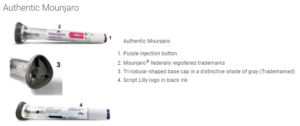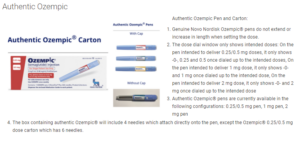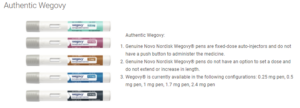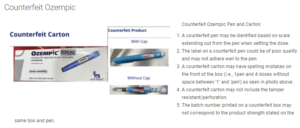A Warning about Counterfeit Mounjaro, Ozempic, and Other Diabetes Medications by Dr. Steven Edelman for TCOYD, 1 July, 2024.
Counterfeit Medications Are a Global Problem: Since the beginning of time, disreputable individuals have tried to make a profit off of people who are desperate to fix an ailment or find a “cure” to their health condition. These unscrupulous individuals often target large populations of vulnerable people who are struggling with sensitive conditions like obesity, erectile dysfunction, and other ailments. They illegally manufacture and market counterfeit medications – everything from fake Viagra and Cialis to imitation Ozempic and Mounjaro, making false claims that they can replicate results from the original FDA-approved medications.
Imitation Drugs Can Be Unsafe: The recent shortages of medications like Ozempic and Mounjaro have caused an influx of imitation drugs internationally. When these fake products are studied by reputable scientists, they are often found to contain varied and questionable ingredients. Many only contain sugar alcohols (which means they essentially do nothing), but the more dangerous variants contain compounds related to the original medication with inaccurate dosing that can cause people to get extremely sick. Oftentimes these substandard medications are made in non-sterile laboratories, which can increase the risk of infection.
This problem is so serious globally that the FDA and World Health Organization (WHO) have both issued warnings about the safety risks of using these imitation products.
Medications like Ozempic and Mounjaro are only approved for adults 18 and over with type 2 diabetes, and they are not approved for cosmetic weight loss. (Wegovy and Zepbound, which are identical versions of Ozempic and Mounjaro, are FDA-approved for weight loss). All four of these medications need to be prescribed by licensed physicians, obtained legally and used safely and appropriately.
Novo Nordisk is the only authorized supplier of the semaglutide medicines Ozempic and Wegovy. Lilly is the only lawful supplier of the FDA-approved tirzepatide medicines Mounjaro and Zepbound, and does not provide tirzepatide (the active ingredient in Mounjaro and Zepbound) to med-spas, wellness centers, online retailers, compounding pharmacies (compounding pharmacies sell custom-made medicines), or other manufacturers.
How to Tell If Your Mounjaro, Zepbound, Ozempic or Wegovy Is Real or Fake
https://youtu.be/Jsw8xmedKvU
Catch My Two Recent Podcast Interviews! by Scott Strumello for Blog.SStrumello.com, 2 July 2024.
 I know the whole matter of the rebate-contracting pharmaceutical sales model, promoted by the largest Pharmacy Benefit Managers (PBMs), is kind of complex for the most people to follow and absorb. So, my being interviewed recently on TWO diabetes podcasts might be interesting listening. I’d have to say the Juicebox podcast interview with Scott Benner was a little more on-point. And my interview with Stacey Simms of Diabetes Connections was more generally on the topic of “the business of diabetes”.
I know the whole matter of the rebate-contracting pharmaceutical sales model, promoted by the largest Pharmacy Benefit Managers (PBMs), is kind of complex for the most people to follow and absorb. So, my being interviewed recently on TWO diabetes podcasts might be interesting listening. I’d have to say the Juicebox podcast interview with Scott Benner was a little more on-point. And my interview with Stacey Simms of Diabetes Connections was more generally on the topic of “the business of diabetes”.
See below for both podcasts, along with links to the podcast episodes themselves, plus my LinkedIn article: https://www.linkedin.com/pulse/ftc-challenge-pharmas-improper-fda-orange-book-patent-scott-strumello-h6ede/ for that) which was the focus of my interview with Scott Benner.
About Scott Strumello: Scott Strumello has been blogging on life with Type 1 diabetes since 2005 at his blog known as “Scott’s Web Log” at https://blog.sstrumello.com/. One of the differentiators of his blog has been his focus on “The Business of Diabetes” because it’s such a major industry and, fortunately, many of the players are publicly-held companies that report quarterly and annual earnings to the SEC.
On social platforms, he began on Twitter at https://twitter.com/sstrumello but has more recently migrated to Threads https://www.threads.net/@sstrumello1. You can follow him (he won’t accept connection requests unless he knows you personally) on LinkedIn at https://www.linkedin.com/in/scottstrumello/ where he published his groundbreaking article “FTC Challenge to Pharma’s Improper FDA Orange Book Patent Listings Poised to Open the Door to Cheaper Weight-Loss Drugs” which can be accessed at https://www.linkedin.com/pulse/ftc-challenge-pharmas-improper-fda-orange-book-patent-scott-strumello-h6ede/
Listen to his recent podcasts: Catch My Two Recent Podcast Interviews!
Research shows how insulin-triggering nutrients vary from person to person by the University of British Columbia and published by MedicalXpress.com, 2 July 2024.
 When it comes to managing blood sugar levels, most people think about counting carbs. But new research from the University of British Columbia shows that, for some, it may be just as important to consider the proteins and fats in their diet. The study, published in Cell Metabolism, is the first large-scale comparison of how different people produce insulin in response to each of the three macronutrients: carbohydrates (glucose), proteins (amino acids), and fats (fatty acids).
When it comes to managing blood sugar levels, most people think about counting carbs. But new research from the University of British Columbia shows that, for some, it may be just as important to consider the proteins and fats in their diet. The study, published in Cell Metabolism, is the first large-scale comparison of how different people produce insulin in response to each of the three macronutrients: carbohydrates (glucose), proteins (amino acids), and fats (fatty acids).
The findings reveal that the production of the blood sugar-regulating hormone insulin is much more dynamic and individualized than previously thought while showing for the first time a subset of the population who are hyper-responsive to fatty foods.
“Glucose is the well-known driver of insulin, but we were surprised to see such high variability, with some individuals showing a strong response to proteins, and others to fats, which had never been characterized before,” said senior author Dr. James Johnson, a professor of cellular and physiological sciences at UBC.
“Insulin plays a major role in human health, in everything from diabetes, where it is too low, to obesity, weight gain, and even some forms of cancer, where it is too high. These findings lay the groundwork for personalized nutrition that could transform how we treat and manage a range of conditions.”
Read more: Research shows how insulin-triggering nutrients vary from person to person
Anatomy of Burnout by Renza Scibilia for Diabetogenic.blog, 4 July 2024.
 There are different types of burnout. Diabetes burnout, advocacy burnout, and just plain life burnout. Diabetes burnout rears its ugly head for many of us living with the condition – sometimes starting as diabetes distress before building and building. Advocacy burnout seems inevitable the more I discuss it with advocate friends. The living with, working in, and supporting others with, diabetes becomes a lot. Too much. So much. And life burnout seems to be inevitable in the fast-paced, never-pause-for-a-breath, always-switched-on lives we live.
There are different types of burnout. Diabetes burnout, advocacy burnout, and just plain life burnout. Diabetes burnout rears its ugly head for many of us living with the condition – sometimes starting as diabetes distress before building and building. Advocacy burnout seems inevitable the more I discuss it with advocate friends. The living with, working in, and supporting others with, diabetes becomes a lot. Too much. So much. And life burnout seems to be inevitable in the fast-paced, never-pause-for-a-breath, always-switched-on lives we live.
When the three collide it’s a triple threat burnout. Welcome to mine.
‘I’m okay’, I said to my friend. And then, ‘It feels too much.’ I felt myself and my mind and the space around me shatter into a million sharp, craggy pieces. And felt my skin being cut against each and every one of those shards.
This is burnout. This is what it feels like. And with it is anxiety and stress and feeling overwhelmed. We all get it to some degree. Diabetes makes it harder. Diabetes advocacy compounds the whole thing even more. Jet lag doesn’t help. Plus there’s a sprinkling of perimenopause over it all. The culmination is a fragility that scares me a bit and leaves me feeling vulnerable. ‘But you seemed fine…’ my friend had said. And I was. Until the burnout took over. And then I wasn’t anymore.
I LOVE this post (and all that Renza writes) … so very real.
Read more: Anatomy of burnout
A Healing and Wholeness Mantra for People with Diabetes by Patricia Daiker for BetterDiabetesLife.com, 2 July 2024.
Love. Joy. Peace. Happiness. Health. Hope.
 These words aren’t just abstract concepts; they’re living, breathing emotions that course through our bodies, shaping our experiences and guiding our paths. They can be the key to easing #DiabetesDistress. This isn’t just a poetic musing—it’s a practice rooted in the science of interoception, the awareness of internal body states. Our emotions are our body’s way of communicating our needs, processing experiences and calming our ego. While it’s important to be mindful and manage your diabetes diligently, you ALSO need to add in something to balance the stress.
These words aren’t just abstract concepts; they’re living, breathing emotions that course through our bodies, shaping our experiences and guiding our paths. They can be the key to easing #DiabetesDistress. This isn’t just a poetic musing—it’s a practice rooted in the science of interoception, the awareness of internal body states. Our emotions are our body’s way of communicating our needs, processing experiences and calming our ego. While it’s important to be mindful and manage your diabetes diligently, you ALSO need to add in something to balance the stress.
I created this mantra in my early twenties during a period when I felt lost. I didn’t know what actions would bring me to a better place, but I sensed that my feelings and emotions held the key. So, I rode my bike and repeated these words, striving to embody and be these traits. Many years later, they remain an anchor point for me.
To embody these feelings, simply say each word, bring to mind the descriptions I’ve provided, and purposefully remember or imagine what your body feels like in those states. Once your brain creates this reality, your body follows, releasing new chemicals, hormones, and shifting into your parasympathetic (rest and repair) state. This is where healing is amplified, connections feel safer, and you regain your footing. It’s a feeling of being home.
Practice this often. It’s free, private, has no negative side effects, and you don’t need anyone’s permission.
Read more: A Healing and Wholeness Mantra for People with Diabetes







I swear There was a commercial on TV Sunday evening about how to get compounded weight loss medications. Hey guess what save your money on the stuff no one can afford. they had a price for Ozempic for around $300.00 / month.
Compounding pharmacies have a purpose and I understand why they exist. Not for this.